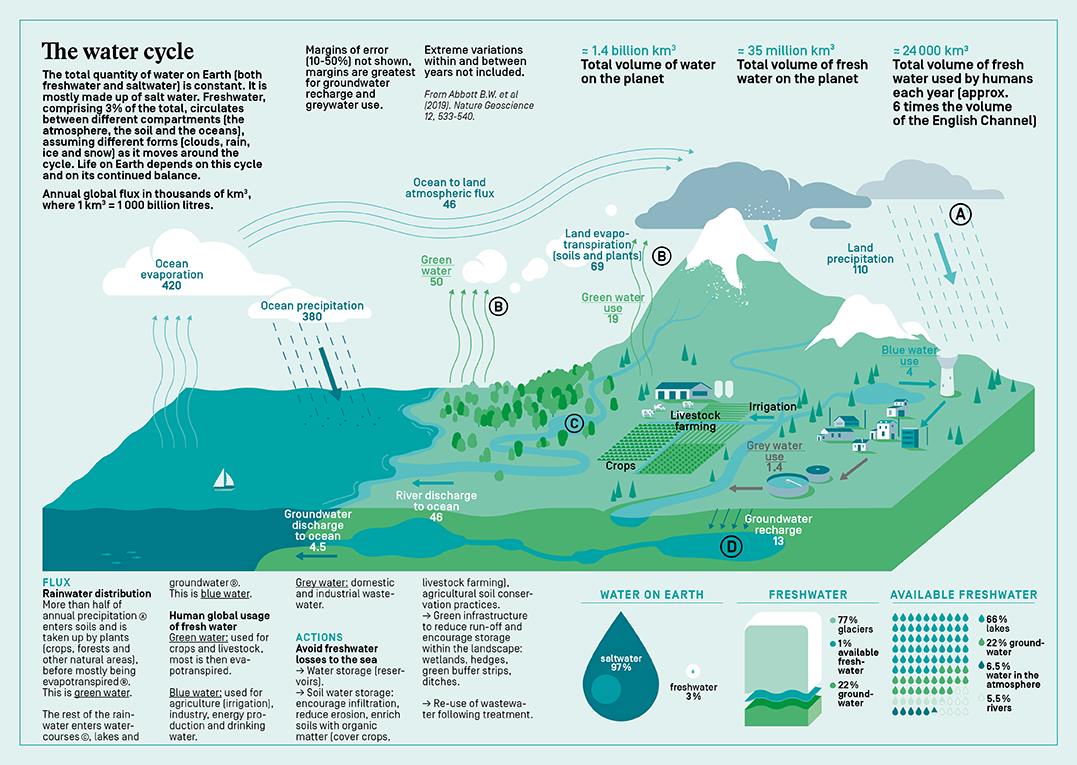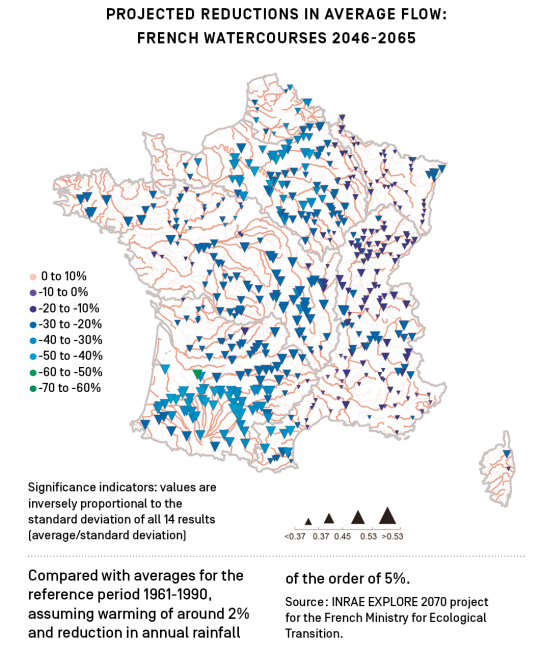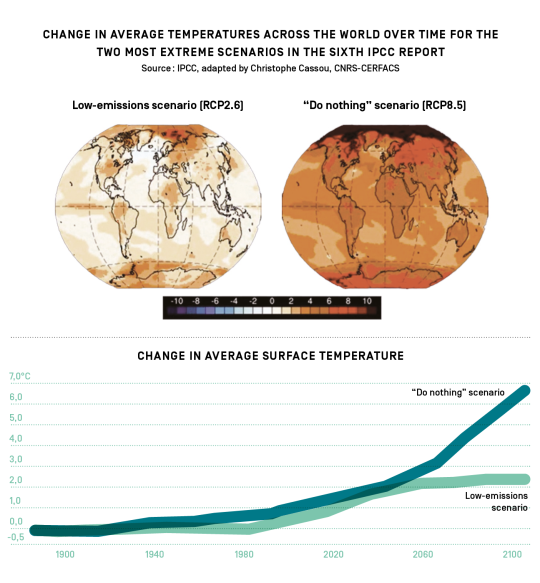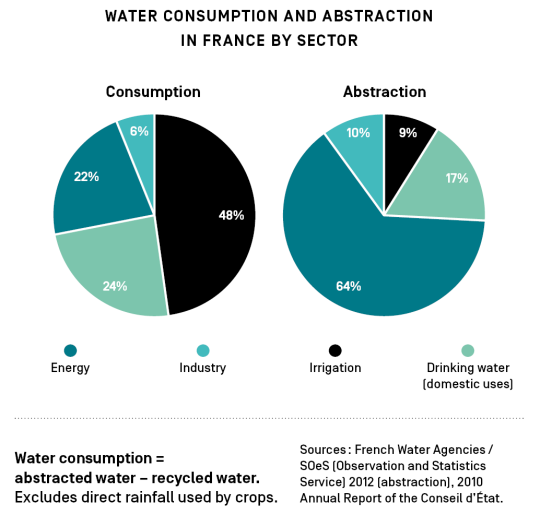Ressources dossier
Climate change and risksA finite resource to treasure
Published on 02 September 2022
Water is a shared, life-giving resource that resembles no other. Compared with the slow pace of geological change, water is in constant flux, shifting between its solid, liquid and gaseous states as it travels interactively between the atmosphere, the land and the oceans. We need to be keenly aware of this cycle because the removal of water from a particular location will inevitably have consequences, both locally and elsewhere in the system. Without understanding the cycle in all its complexity, it is impossible to form a judgement on a matter of critical importance for both human life and the wider ecosystems in which we operate: will our planet run out of fresh water?
A finite resource with limited opportunities for renewal
The water cycle is a closed cycle, with no gains or losses beyond the planet’s atmosphere. The total volume of water on Earth may seem vast, but just 3% of it takes the form of fresh water (found in glaciers, lakes, watercourses and aquifers) and of that, two thirds is locked away in ice. To make matters worse, what fresh water we do have is not evenly distributed across the world.

Freshwater = 3% of the water on Earth, of which 1% is available
The fresh water used by humans doesn’t just disappear. Much of it may leave the cycle for a time but it then re-enters it. However, the water returned by humans to the cycle can cause levels and types of pollution that cannot be completely removed. It is becoming increasingly evident that, while many of the contaminants discarded by humans (metals, medicines, detergents, microplastics, pesticides, microorganisms, etc.) will either be removed by wastewater treatment facilities, break down naturally or, failing this, be stored in the soil, there are others that are resistant to treatment processes or are transported by precipitation, entering surface-water flows and groundwater. If pollution levels exceed acceptable limits, water can no longer be used for some purposes. In France, thousands of drinking-water storage facilities have had to be decommissioned because they failed to meet required quality standards 1. What is more, higher concentrations of pollutants occur where there is less water available to dilute them, not just demonstrating the close relationship between water quantity and quality but also constituting a serious hazard for the survival of the aquatic ecosystems of our lakes and rivers in particular. One way to increase the available volume of fresh water on a large scale is to desalinate seawater or brine. Despite the energy they consume and the pollutants they emit via brine discharges (in the form of hot water with high concentrations of salt and other minerals), desalination plants are increasingly popular in some regions of the world, where governments look to them to secure the supply of drinking water, notably in the Middle East and in North Africa. Such plants currently produce 2% of drinking water across the globe.
Water is, then, a finite resource. How quickly it can be replenished in a given location and how much uncontaminated water humans return to the cycle will depend on the purification capabilities of the systems in operation, whether these are regional or national.
1. www.eaufrance.fr/repere-captages-fermes
Growing risk of water shortages in a rapidly changing climate

The results of the Explore 2070 project (see map to the right) show that average river discharge levels in France are expected to decline sharply in the next 30 years, with an anticipated 50% reduction in the South West and the Parisian basin in particular.
The situation in France illustrates a global problem associated with climate change – the rise in average air temperature is effectively increasing evaporation from bodies of water, soil and plants and affecting rainfall patterns, with more intense rainfall events and increased winter rainfall in temperate zones, increased rainfall in equatorial zones and reduced rainfall in Mediterranean and tropical regions. Ultimately, the changing climate is speeding up the water cycle, as higher levels of evaporation cause more extreme rainfall, thereby increasing surface run-off into watercourses and the oceans and failing to replenish the water table through infiltration. It also ushers in a probable increase in the frequency and intensity of floods, heat waves and droughts. Meanwhile, with the more marked temperature rises witnessed at the Earth’s poles, melting glaciers and ice sheets are already causing substantial losses of fresh water to the oceans and sea-level rises are predicted to reach 60–110 cm by 2100, if current trends persist. The net result, in every scientific projection, is a redistribution of water resources at both national and world scales.
Although the total volume of water on the planet may remain constant, its inhabitants will experience an increased risk of fresh-water shortages that will vary in severity by region, season and year.
The climate emergency : change at unprecedented speed

Since 1900, greenhouse gas emissions associated with human actions have caused the average temperature across the world to rise by 1.07°C. If we continue on our current course (known as the "do nothing" scenario), there will be a further average temperature increase of 6°C by 2100 (rising to a possible 10°C at the Earth’s poles), transforming the world we live in. By contrast, the "low carbon" scenario (+1°C by 2100) assumes that we will achieve carbon neutrality by 2050. From that date, multiple possible pathways open up, with no certainty as to which will become a reality. Indeed, the only certainty, given the inertia of the system, is that what happens in future will depend on what we are doing now to mitigate climate breakdown. This prediction was confirmed by the IPCC’s 2021 Physical Science Basis report for its 6th assessment cycle. Not only have the IPPC’s projections so far proved accurate, confidence levels for future scenarios have also risen as the result of improvements to modelling.
Water "diversion": a local source of tensions?

In France, farming accounts for 9% of water abstractions, but a hefty 48% of water consumption (in the sense of the water lost from the local environment), mostly for crops. This sector tops the consumption charts at local level because plants do not return the water they use directly to the field. Instead, the water is evapotranspired 2, re-entering the water cycle in the form of vapour before falling again elsewhere as precipitation. Although this water is effectively lost to the local environment, viewed from a wider perspective, it is not lost at all but is instead "diverted" to another part of the cycle. Nevertheless, the process differs from that found in conventional or nuclear power plants, for example, where water used for cooling is largely returned to the cycle at a point close to the extraction site. Unlike the water from agriculture, such water is thus available for local reuse, subject to regulatory criteria on temperature and quality (There are a few exceptions, where discharge occurs some distance from the extraction point, particularly in piped systems).
As tensions mount over water, decisions on its allocation to different sectors are becoming increasingly fraught (see part 2 of this dossier).
2. Evapotranspiration is the combined total of water evaporation from the soil and the ‘transpiration’ of plants, which discharge almost all the water they have absorbed/taken up into the atmosphere through the pores in their leaves.
Climate mitigation: a global source of solutions?
Agriculture, with its high water consumption and greenhouse gas emissions, is often portrayed as a prime cause of climate instability, but this sector can also provide some of the solutions, its plants and soils can act as a vast carbon sink. This storage capacity is significant, as the 4 per 1,000 initiative, supported by INRAE, demonstrates.
4.3 billion tonnes of carbon
Annual increase in global CO2 emissions linked to human activities (average for the period 2009 – 2018).
With the threat of water shortages on the horizon, there is an urgent need to devise new agricultural systems that are not only less greedy for water, but are also able to act on the causes of water deficit by mitigating the heating climate through carbon storage and, most importantly, reducing greenhouse gas emissions (carbon gas – CO2, methane CH4, and nitrous oxide – N2O). In this dossier, we embark on a tour of this necessary re-imagining of agriculture, both rainfed and irrigated, taking a closer look at ways to improve water management.
The 4 per 1000 initiative
INRAE has been strongly involved in the ‘4 per 1000’ intergovernmental initiative, introduced in 2015 at COP 21 in Paris. The starting premise for this "Soils for Food Security and Climate" project was the striking statistic that a 4‰ annual increase in soil carbon storage across the world (1,500 x 4‰ = 6 billion tonnes) would be sufficient to compensate for the annual increase in CO2 emissions brought about by human activities (estimated at 4.3 billion tonnes). Needless to say, the calculation applies only if all existing carbon storage areas (forests, grasslands, wetlands) are maintained, and if we can cease to allow our soils to degrade.
INRAE’s researchers have demonstrated that, in France, the greatest potential carbon sink lies in the soils beneath our field crops, and this can be put to use by practices such as the interplanting of cover crops and agro-forestry.
-
Pascale Mollier / translated by Teresa Bridgeman
Author
